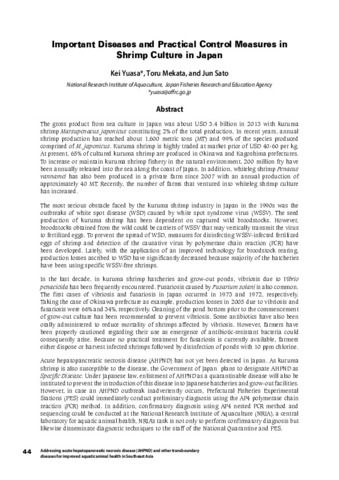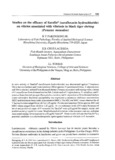Luminescent vibrios associated with mortality in pond-cultured shrimp penaeus monodon in the Philippines: Species composition

View/Open
Date
2001Page views
516Metadata
Show full item recordCited times in Scopus
- Citations
- CrossRef - Citation Indexes: 31
- Scopus - Citation Indexes: 60
- Captures
- Mendeley - Readers: 39
Share
Abstract
Heavy mortalities due to luminescent vibriosis have been observed among pond-cultured Penaeus monodon shrimp in the Philippines. The species composition of luminescent Vibrio associated with mortalities was determined. A total of 189 luminescent bacteria isolated from the hepatopancreas of affected shrimps, rearing water and seawater from different shrimp farms in 11 provinces of the Philippines were examined for their morphological, physiological and biochemical characteristics. Results revealed a varied composition of Vibrio species. The most dominant luminescent Vibrio species was V. harveyi (65.5%) followed by V. logei (7%), Photobacterium sp. (6%) and V. orientalis (1%). Some isolates, based on their characteristics, were identified as V. campbellii (16%), V. mediterranei (3%), V. fluvialis (0.5%), V. cholerae (0.5%) and V. splendidus II (0.5%), which are known as non-luminescent Vibrios. V. harveyi is thought to be the major etiological agent associated with the luminescent vibriosis in pond-cultured P. monodon and its pathogenicity was confirmed through intramuscular injection to shrimp. Experimental infection showed that V. campbellii was also pathogenic to P. monodon.
Suggested Citation
de la Peña, L. D., Lavilla-Pitogo, C. R., & Paner, M. G. (2001). Luminescent vibrios associated with mortality in pond-cultured shrimp penaeus monodon in the Philippines: Species composition. Fish Pathology , 36(3), 133-138. https://doi.org/10.3147/jsfp.36.133
Subject
Taxonomic term
Collections
- AQD Journal Articles [1248]
Related items
Showing items related by title, author, creator and subject.
-
Important diseases and practical control measures in shrimp culture in Japan
Yuasa, Kei; Mekata, Toru; Sato, Jun (Aquaculture Department, Southeast Asian Fisheries Development Center, 2016)The gross product from sea culture in Japan was about USD 3.4 billion in 2013 with kuruma shrimp Marsupenaeus japonicus constituting 2% of the total production. In recent years, annual shrimp production has reached about ... -
Studies on the efficacy of Sarafin® (sarafloxacin hydrochloride) on vibrios associated with vibriosis in black tiger shrimp (Penaeus monodon)
Pakingking, Rolando V., Jr.; Lacierda, Erlinda; Torres, James L. (Fish Health Section, Asian Fisheries Society, 2002)In vitro activity of Sarafin® (sarafloxacin hydrochloride) was determined against 7 luminous Vibrio harveyi isolates and 3 non-luminous Vibrio species (V. parahaemolyticus, V. alginolyticus and Vibrio species) isolated ... -
Current status of shrimp farming and diseases in Cambodia
Lang, Ouch; Sothea, Mey (Aquaculture Department, Southeast Asian Fisheries Development Center, 2016)The farming of penaeid shrimps in Cambodia began in 1989 and has significantly expanded since 1991. Shrimp cultivation has been carried out in the four coastal provinces, i.e. Kampot, Kep, Preah Sihanouk Ville, and Koh ...






